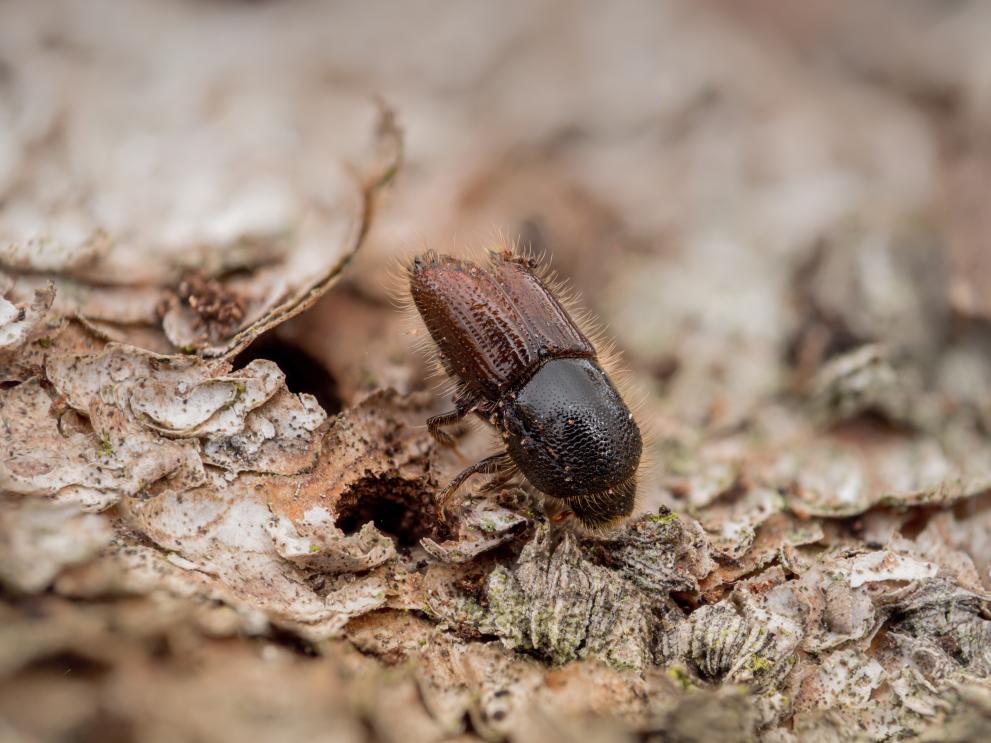
The European spruce bark beetle (Ips typographus) mainly attacks Norway spruce (Picea abies). Outbreaks can kill large numbers of trees, seriously affecting ecosystems and leading to economic losses in forests managed for timber production. Climate change is predicted to exacerbate the problem as warmer temperatures expand the beetle’s range, and warmer temperatures in northern forests increase the probability of more than one generation of beetles developing each year. Meanwhile, as trees experience more frequent drought stress they will also be more vulnerable to the impacts of attack.
Wetter winters and drier summers have indeed been linked to severe attacks in northern European forests. For example, record-breaking heatwaves and drought in 2018 resulted in the largest documented bark beetle outbreak in Sweden, killing 17 million cubic metres of spruce over the following two years.
Various risk factors that intensify beetle impact have been found – for instance trees at the edge of forests and those older than 60 years are usually worst affected; but when beetle populations are very high, healthy and young trees are also attacked. Better information is needed to inform management actions. For example, forest managers often pre-emptively fell large numbers of trees to try and prevent spread of the beetles, but some of the volatile chemicals released by the trees may actually attract the species to adjacent stands. For example, cut conifers emit terpenes, which bark beetles use to detect suitable host trees.
To better predict susceptible areas, therefore, researchers looked at which environmental characteristics of Norway spruce forests were most correlated with risk of bark beetle outbreaks, using modelling to analyse a large data set covering a 48 600-square-kilometre area in south-east Sweden.
They considered stand (a section of a forest) attributes, topography, soil type and wetness, proximity of clear-felled areas and previous beetle attacks, as recorded during the 2018 drought year, 2019 and 2020. Data on bark beetle presence was collected by forestry harvester machines equipped with satellite navigation, providing co-ordinates of 640 000 trees removed due to infestation or as a control measure. The researchers used modelling, including a machine-learning method, to find the relative importance of features related to outbreaks, considering their interdependence.
Using patterns revealed by modelling, they were able to identify key risk factors for severe beetle outbreaks. For example, spruce and mixed coniferous forest (where 70% or more of crown cover is made up of spruce, or pine and spruce) were at higher risk of attack than those with a mix of deciduous and coniferous trees (where neither make up more than 70% of crown cover). This effect was more pronounced during normal weather – mixed forests of deciduous and coniferous trees were similarly susceptible during drought.
Areas with larger numbers of older trees (average canopy height over 15 metres) were also most susceptible. During the drought year, however, stands of lower height were at similar risk, suggesting that young trees are also susceptible when undergoing drought stress. Risk was also increased in upland forests; on north-eastern slopes1; on drier soils and those that hinder deep-rooting; where stands were within 100 m of an area clear-cut (when all or most of the trees are felled at the same time) in the last 10 years, or within 50 m of the forest edge. Risk was greatly increased within 125 m of previous attacks2.
One of the key findings was that the impacts of attacks during drought continue into subsequent years, leaving clusters of trees in proximity to attacked areas with a high susceptibility to attack in years with normal weather.
The researchers acknowledge that the Swedish Forest Agency’s current risk map is rated about 87% accurate, but the method developed here performs slightly better, highlighting how geospatial data and machine learning may be used to guide management and adaptation. There are often synergies between climate adaptation and reducing the impact of bark beetle, note the researchers. For example, since one of the risk factors is a high proportion of spruce, promoting diverse forests – with trees suited to future conditions – is one such synergistic strategy.
Recent clear-cuts also appear to attract beetles, which may also inform management actions. Meanwhile, the researchers suggest that risk maps could be updated with new harvester data, based on this methodology, or monitoring could employ remote sensing of beetle attacks. They posit that forest managers should promote such data collection across large geographical areas.
Footnotes:
- The position at upper slopes or uplands can lead to higher sun exposition and increased soil water runoff.
- Adult beetles hibernate either under the bark of trees attacked or in the forest floor litter. When they swarm the following spring the beetles can spread.
Source:
Müller, M., Olsson, P.O., Eklundh, L., Jamali, S. and Ardö, J. (2022) Features predisposing forest to bark beetle outbreaks and their dynamics during drought. Forest Ecology and Management, 523: 120480. Available from: https://doi.org/10.1016/j.foreco.2022.120480
To cite this article/service:
“Science for Environment Policy”: European Commission DG Environment News Alert Service, edited by the Science Communication Unit, The University of the West of England, Bristol.
Notes on content:
The contents and views included in Science for Environment Policy are based on independent, peer reviewed research and do not necessarily reflect the position of the European Commission. Please note that this article is a summary of only one study. Other studies may come to other conclusions.
Details
- Publication date
- 15 March 2023
- Author
- Directorate-General for Environment

